Defining coastal erosion is rather straightforward. But to understand the phenomenon is far from easy. There is a widespread perception that coastal erosion is always irreversible, especially, for example, immediately after a storm event when erosion is more evident. This sometimes results in a call from both local residents and political representatives for hard engineering works to be constructed. There is little public awareness of the physics behind coastal processes that causes the difference between structural and episodic erosion. Few will know how natural coasts change due to fluctuations in forcing. And that erosion can be followed by coastal accretion when boundary conditions change, either at a seasonal, annual or much longer, geological time scale.
1. Interplay of sediments, wind and water
Understanding coastal erosion processes requires an insight into all the factors that interact along the shoreline and an awareness of different time scales. On geological time scales, coastal evolution in sedimentary environments is governed by the demand and supply of sediments [3, 4]. Sediment demand of a coast is determined by the rate of relative sea-level rise and by the morphology of the coastal plain. Sediment supply is determined by the availability of sediment and by the transport capacity of wind and water. The balance between sediment demand and supply drives the evolution of the coast (figure left): when supply is greater than demand, the coast will grow seaward, when demand equals supply, the coast will stay in place, and when the supply is insufficient, the coast will tend to retreat.
|
|
Coastal evolution is governed by the balance between
demand and supply of sediment (modified from [3]) |
Diagram explaining coastal evolution through a combination of
sea level changes and sediment availability (modified from [5]) |
The diagram on the right teaches us that with sea level rise, the coastline could be stable or even grow seaward, if there is sufficient sediment supply. It also shows that even without coastal erosion the coastline can retreat when the sea level rises and causes submergence of the coast. If we look at what happens during a storm only a part of the long term processes is visible. On a sandy coast, for example, a combination of high tide and strong winds pushes up the sea water level, exposing the beach and dunes to heavy attack by the incoming waves, usually resulting in erosion. Sand is dragged down the slope by the down rush causing erosion of the beach and dunes and undermining of the dune toe. Part of the dune face may collapse and this slumped sediment will slide downwards where it can be eroded further again by wave-induced processes. The sediment is then transported to the sea where it will settle at deeper water. During a subsequent calmer period some of the sediment may return to the coast through onshore directed wave-driven and wind-driven transport, usually resulting in accretion in the beach zone. However, longshore currents may also remobilise the sediment, leading to further sediment movement away from the original location.
Definition of coastal erosion
Coast erosion is the process of wearing away material from a coastal profile due to imbalance in the supply and export of material from a certain section. It takes place in the form of scouring in the foot of the cliffs or dunes or at the subtidal foreshore. Coastal erosion takes place mainly during strong winds, high waves and high tides and storm surge conditions, and results in coastline retreat and loss of land. The rate of erosion is correctly expressed in volume/ length/time, e.g. in m3/m/year, but erosion rate is often used synonymously with coastline retreat, and thus expressed in m/year [2]. |
This is a simplification of the processes involved and these will vary according to the types of coast in question, cliff, coarse gravel or sandy beaches, etc. What is clear from this description is that coastal erosion is a dynamic process. It is often event-driven (a storm) and its consequences may be at least partially reversed during calmer periods. Such events are superimposed on the long term coastal evolution, described earlier. Coastal behaviour also has a spatial dimension: the longshore currents may permanently remove sediment from the shore, but they also may bring new sediments from elsewhere. Therefore it is important to describe these processes in relation to the concept of the coastal cell.
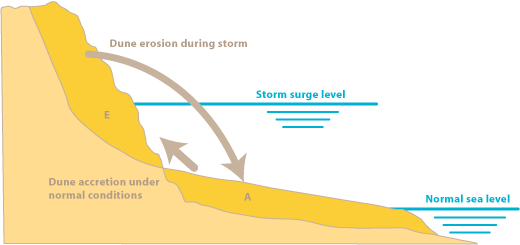
2. The coastal cell as unifying concept
A coastal cell is defined as a relatively self-contained unit within which sediment circulates. A cell contains a complete cycle of sedimentation including sources, transport paths and sinks. Its boundaries separate those parts of the coast that are interdependent from those that are independent in terms of physical processes. Delineating the coast into several coastal cells is most easily achieved by using natural or artificial boundaries, such as headlands, capes or long groynes.
The adoption of the coastal cell concept facilitates setting up a sediment budget, i.e. a mass balance of inputs and outputs of sediment for the cell. Possible sources of sediment are riverine input, onshore transport of sediment from offshore marine deposits, and inflow from adjacent cells through longshore transport. Human interference through nourishment (artificial deposition of sand from dredging of adjacent offshore areas) may also form an important input. The coastal cell also loses material in various ways, including trapping in deep offshore channels and submarine canyons or mining. Sediment may be transported to estuaries, lagoons and inner seas and by wind to beaches and dunes from where it may only return to the beach through further erosion or exceptional storms. Longshore currents also may transport sediments to adjacent coastal cells.
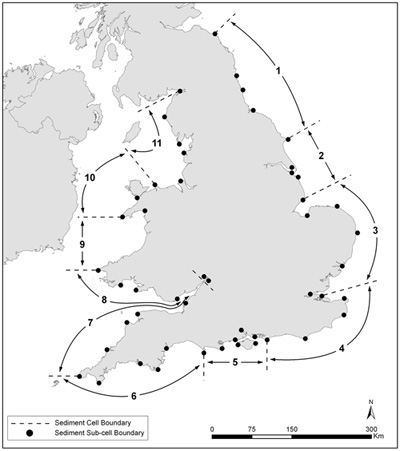
Coastal sediment cell and sub-cell boundaries for
England and Wales
The net balance between losses from and inputs to a coastal cell determines, to a large extent, whether a coastline is eroding or accreting, especially in the longer term. It is clear that any human interference in these processes, such as the blocking of sediment transport by building a jetty or breakwater, or sediment starvation through reduced riverine input could have repercussions on the delicate natural balance and thus on erosion patterns. Transport rates for each of these processes are used to model the changes in the sediment budget, which makes it possible to predict future coastline fluctuations caused by such human interventions.
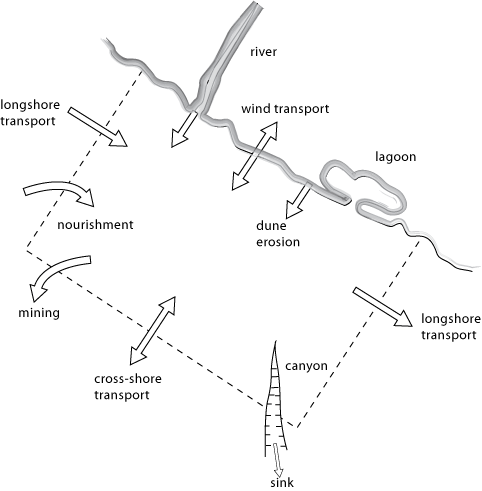
The coastal cell and its sediment transport pathways
3. When does erosion become a problem?
Coastal erosion becomes a problem when there is no room to accommodate change: a highly urbanised coastal zone will certainly face difficulties with coastal erosion. The question is how much room is needed and what human uses are compatible with a dynamic coastline. Unless we know the natural behaviour of the coast, we cannot formulate a sustainable, economically rational and socially acceptable coastal management strategy.
With increasing urbanisation of European coasts, the demand for shoreline defences and erosion control also increases. This could lead to a self-reinforcing effect as additional property and economic activities require further and often more robust defences [6]. Short-term economic gain often stimulates this development, without taking into account erosion risks. These developments all lead to reduced coastal resilience since the coastline has nowhere to move. It is questionable whether this type of development is sustainable in the long term, especially in view of climate change.
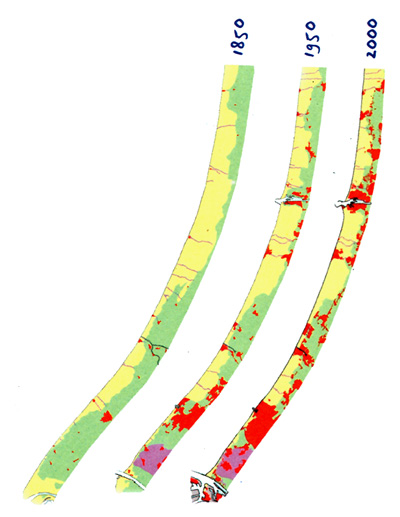
Urban sprawl along the Dutch coast. Urbanised areas
appear in red. Courtesy: Rijkswaterstaat
4. How does climate change affect coastal erosion?
Climate change will probably lead to an increase in coastal erosion. In terms of the main drivers for accelerated erosion, the relative rise of sea level is the most important. As explained earlier, a rising sea level implies an increase in sediment demand, which if not supplied results in coastal retreat. Current predicted changes in sea level estimate a rise of up to 0.6 m by 2100 [7]. Higher sea levels will raise extreme water levels, allow waves to break nearer to the coast and transmit more wave energy to the shoreline. This will promote erosion and coastal retreat at sediment starved locations. Sea-level rise is therefore likely to cause an inland migration of beaches and the loss of up to 20% of coastal wetlands [8].
Other drivers that may exacerbate erosion rates are increased storminess, higher waves and changes in prevalent wind directions. The condition and performance of existing coastal defence structures may also deteriorate through interactions with rising sea level, higher waves, more severe surges and changes in the shape of the shoreline. Several recent studies indicate that coastal protection strategies and changes in the behaviour or frequency of storms may be more important than the projected acceleration of sea-level rise in determining future coastal erosion rates [9].
It has been estimated that for England and Wales, a worst case climate scenario could lead to nine times more severe erosion than the present day [10]. In The Netherlands, the volume of sand needed to nourish and maintain the coastline could increase from 12 to 80 Mm3 per year due to predicted sea level for 2050.
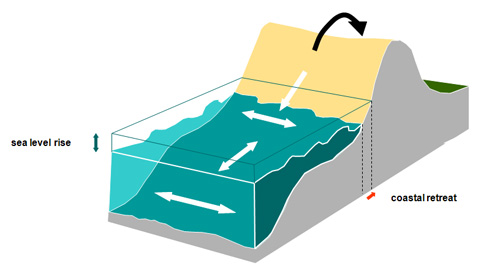
Principle of sea level rise causing coastal retreat
5. Who is responsible for erosion management?
Because the cause of coastal erosion is not always directly evident and is often seen as a natural phenomenon, the question of who is responsible for its management is not an easy one. People often tend to look towards public authorities when it comes to taking measures. Hardly ever are parties responsible for coastal erosion made accountable for the consequences. Public expenditure in Europe specifically for coastline protection against the risk of erosion and flooding reached an estimated €3,200 million in 2001. It is highly probable that private funding for coastal erosion management does not amount to 10% of the figure for public expenditure [1]. Even more worrying is the fact that much of the government spending is done in a rather piecemeal and informal way, given there is no strategic erosion policy at national level. This therefore reduces the effectiveness of these measures. Many hard engineered protection works have only a positive effect in the short time and can exacerbate erosion at adjacent locations. Many countries lack a coordinated, well-planned and explicitly formulated policy on coastal erosion or indeed coastal management more generally.
|